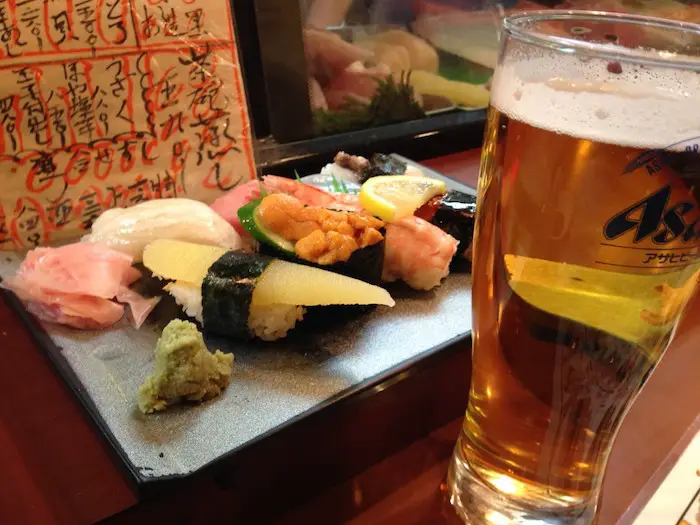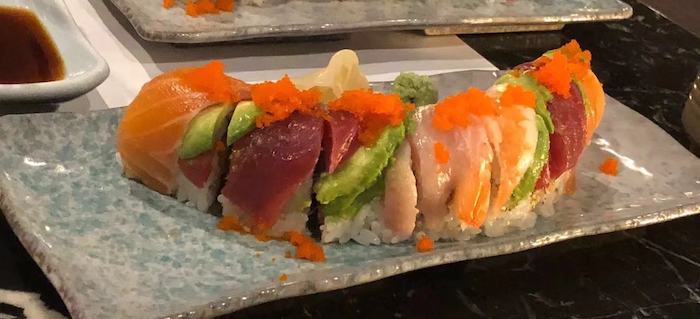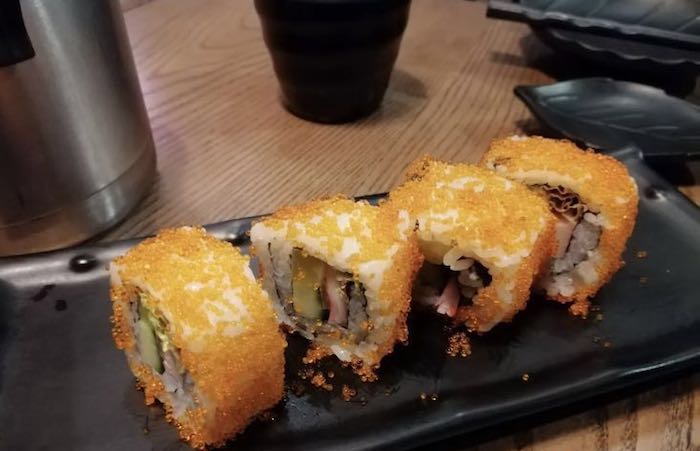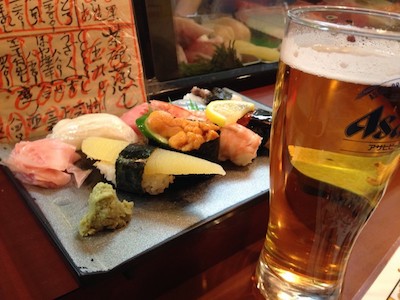We are reader supported. When you purchase through links on our site, we may earn an affiliate commission. Also, as an Amazon affiliate, we earn from qualifying purchases.

Let’s say you walk into a restaurant and order a spicy tuna roll and one California roll thinking that you are eating healthy. I hate to burst that bubble of happiness but do you know that your food is equivalent to eating six slices of white bread, 1 tbsp mayo, 1/4 avocado, 1oz. surimi, and barely-there tuna.
Does sushi have carbs then? Yes, they do. One piece of regular sushi roll can have about 8 grams of carbohydrate. The main source of carbs in sushi is white rice, which has a high starch content. Other ingredients like breaded tempura, rich sauces, glazes, and mayo can also increase your carbs intake.
The biggest problem with eating high-carbs food is that they bulk up your daily food intake. As a result, there is not much room left for nutritious food. Sushi has a certain health halo, which makes people believe that they are eating healthy no matter what type of sushi they order.
If you dig deeper into facts and nutritional details, you can see that the choices you make bring about a lot of difference. Traditional maki rolls served in Japan are low-fat and low-calories, while the fancy rolls coated in sauces and glazes have a higher percentage of carbs and sugar.
Risks Of Eating A High-Carb Diet
Studies have shown that people who consume a high carb diet have a lower mortality rate than those who eat the least. Too much carbohydrate in the diet has been linked to strokes and heart diseases because it tends to increase the bad blood fats known as triglycerides.
No wonder, health experts tout the numerous benefits of low to no-carb diets such as the Atkin’s Diet, the Dukan diet, the Ketogenic diet, the South Beach Diet, and the Paleo diet. Despite carbs having a bad rap, going very low with carbs intake can do more harm than good.
I would not recommend cutting back on carbs entirely, but to understand the difference between bad and good crabs. When you shun carbs completely, the body starts burning protein and fat to gain energy. This results in side effects like bad breath, frequent headaches, foggy vision, constipation, and moodiness.
Unless you want to do ketosis, it is imperative to maintain a balance of good carbs in your food. Avoid fried food, pasta, and bread that are loaded with carbs and have very little fiber. Sushi contains white rice, which is also high in crabs but let’s look at the brighter side – sushi is not just the rice, but it is supplemented with lots of fresh green vegetables and lean meat.
So, even though sushi does have carbs, you also get a lot of fiber and protein in a single roll. The key is to ensure that you choose the healthy rolls when eating out at sushi restaurants and go easy with the rice and sauces when making sushi rolls at home.
Comparing The Carbs Content In Different Sushi Rolls
When something contains white rice as the most essential ingredient, you know that the dish will have a substantial amount of carbs in it. In sushi, the amount of carbohydrates per roll may vary depending on the other fillings/ toppings besides sushi rice. Here are some popular sushi rolls with their approx. carbs content to help you compare and make the right choice.
# Shrimp Tempura Roll
I know it’s hard to say ‘No’ to a beautifully created crunchy shrimp tempura roll, but do you know the level of carbs you intake with one roll? The lean shrimp is coated in a heavy tempura batter and fried in hot oil. So, with all that sushi rice, fried shrimps, and sauces, the carbohydrate level is about 64 grams.
If you want a low-carb diet, I would recommend that you swear off the artery-clogging fat in these types of rolls or enjoy them only occasionally. Those who must have shrimp tempura rolls once in a while, consider cooking at home to control the amount of sushi rice and other ingredients.
# Rainbow Sushi Roll

This type of roll is not only high in carbs and calories but also loaded with good portions of fish that balances your meal. A good rainbow sushi roll will have real crab, sushi-grade salmon, tuna, and other varieties of fish.
The crabs content in the roll is about 50 grams, but there are sumptuous fish fillings as well as toppings that give you lots of other essential nutrients. Read my article to learn more about rainbow roll and recipe to make it at home.
# Eel and Avocado Roll
Eel is rich in omega-3s, but unfortunately, it is marinated and covered in a sugary brown sauce that overcomes both the delicate flavor and nutrition. If you order this sushi roll at the restaurant, make sure it’s the only one complemented with other veggie rolls and side dishes. The carbs content for the roll is 37 grams and total calories amount to 372.
# Salmon and Avocado Roll
This delicious sushi roll is also high in calories and contains about 42 grams carbs, however, it includes healthy fat from salmon and avocado. The high carbs content is perfectly balanced by the health benefit of lean fish and fresh avocado. Avocado is rich in fiber so you feel fuller after a few pieces and this saves you from overeating.
# Philadelphia Roll
This one comes as a surprise packet because most people will consider this an unhealthy roll. Cream cheese is definitely not a great option if you are trying to lose weight, but if you are cutting carbs, Philadelphia Roll keeps you on the safe side.
The perfectly cut cucumber and salmon packs a lot of nutrition, restricting carbs at just 28 grams. I have created an article that contains interesting facts about Philadelphia Roll and recipe to try it at home.
# Spicy Tuna Roll
If you are a health-conscious individual, I would recommend you to stay away from anything that has ‘crunchy’ or ‘spicy’ in its name. The Spicy Tuna Roll, for example, contains pieces of raw tuna mixed with mayo sauce and sriracha sauce.
As a result, the calorie meter rises high even though carbs level stays at 26 grams. I would suggest that you order a plain tuna roll instead and add a dollop of wasabi to pack a heat punch. If you must have spicy tuna roll, prepare it at home to cut back on the sauces. Check the recipe here.
# California Roll

If you are a sushi fan, I am sure this is one of the go-to rolls you like ordering at restaurants or take-aways from the grocery stores. As there’s no raw fish involved, this is a great form of sushi for the beginners who are not comfortable with eating raw fish.
However, the presence of imitation crab makes it rank low in nutritional value. The level of carbs is about 38 grams and total calories amount to 255. Read my article that explains the origin of California roll and recipe to try it at home.
Ways To Reduce Carbs In Sushi
Are you looking for ways to reduce the carbs count in your sushi? I suggest cooking sushi at home when you are on a diet and craving for this Japanese delicacy because there are so many options you may try to keep the carbs low. Here are a few ways to enjoy low-crabs sushi.
#1. Substitute white rice with brown rice
White rice is stripped of all the essential nutrients and contains a high percentage of starch. As the grains are highly processed, they contain what is known as the bad carbs. Brown rice is a form of whole grains that contain high levels of fibers and nutrients. It also contains carbs but significantly less than its white rice counterpart.
#2. Use quinoa instead of white rice
Quinoa is a good low-carb substitute for white rice because it has almost the same taste and texture as rice. Follow the instructions mentioned on the box when cooking quinoa and use just the right amount of seasoning to resemble the flavor of vinegared sushi rice. This type of grains has a good binding ability and their amino acids and fiber content make them healthier.
#3.Replace white rice with Cauliflower rice
This is one of my favorite options because it completely replaces grains with a vegetable that is rich in fiber. What I love most about cauliflower rice is that it is easier to achieve a similar grain-like texture. There are two ways of using cauliflower rice. Shred the cauliflower heads in food processed to form tiny pieces. You may also stir-fry to slightly soften the texture. The cooked cauliflower rice may then be seasoned with vinegar before using in sushi.
#4. Opt for riceless sushi
If you have made up your mind to completely cut back on carbs, you can still enjoy a riceless sushi roll. Use one of the substitutes like cauliflower rice or quinoa, or you may choose to make temaki rolls comprising of only raw fish and veggies. You can use different varieties of fish and lots of veggie ingredients to make your riceless sushi more filling. Read my article that explains – what is sushi without rice called.
#5. Avoid crunchy and fried fillings
Sushi is all about enjoying the delicate flavors of raw fish, seafood, and green veggies. The westernized rolls may be tempting for your tastebuds but I strongly suggest that you avoid the crunchy and deep-fried fillings like shrimp tempura, sweet potato tempura, and so on. The breaded fillings are made using wheat flour and cornstarch that can add a lot of carbs to your sushi.
#6. Skip sugar when seasoning sushi rice
Most people add sugar and salt when seasoning cooked sushi rice with vinegar and these little things add up to the total carbs count in sushi. If you are seriously looking for ways to cut back on carbs, avoid seasoning your sushi rice or just use vinegar, without mixing it with sugar.
#7. Use very less rice when making sushi rolls
Another method to cut back on carbs without compromising with the flavor or taste of sushi is to use very less sushi rice when making rolls. While eating out, you may ask for temaki rolls that contain less quantity of rice. Those who like cooking sushi at home can reduce the amount of seasoned sushi rice used per roll from half a cup to a quarter cup.
#8. Drink green tea instead of sake
Sake may appear to be that perfect beverage to pair with sushi but please be warned that the sweet and sugary sake is loaded with carbohydrates. You would not want to add further carbs after a sumptuous sushi meal. Replace the sake with green tea instead and reap its various health benefits such as effective antioxidant, digestion aid, etc.
#9. Use gluten-free soy sauce
Regular soy sauce is made from soybeans, wheat, water, and salt, which means there’s a good amount of carbs coming from wheat. To reduce your carb intake from sushi, you can make a healthier choice by asking your chef to use tamari instead of regular shoyu. Tamari contains less to no wheat, so this is a healthier way to add umami to your sushi.
Low-Carb Sushi Roll Recipe
Everyone in my family loves sushi so we like making our own sushi dinner at least once or twice a week to avoid the exorbitant restaurant bills. Here’s my recipe for a filling but low-carb sushi meal with sushi-grade fish, green veggies, and brown rice.
What you will need:
- 1 1/2 cups cooked brown rice
- Nori sheet
- 2 tablespoon brown rice vinegar
- Sushi-grade salmon, cut into thin strips
- 1 1/2 tablespoon low-sodium shoyu
- 1/4 teaspoon freshly grated ginger
- Finely chopped scallions
- Half Japanese cucumber, cut into thin strips
- Blanched baby spinach, chopped
- 2 carrots, cut into thin strips
Instructions
Take a large bowl and mix cooked brown rice (must be at room temperature) with brown rice vinegar, grated ginger, soy sauce, and green onions.
Prepare the fillings by cutting the cucumber, carrots, and spinach in the same size. Use a sharp sushi knife to cut sushi-grade salmon into thin strips.
Now, lay a bamboo mat on the kitchen table and cover it with a plastic sheet. Keep the nori sheet over the covered bamboo mat, rough side facing up.
Take less than half a cup of brown sushi rice and layer it over the nori sheet evenly, leaving a one-inch gap on the top part.
Arrange the fillings towards the middle of the rice layer, first the salmon strips, then cucumber, carrots, and spinach.
Keep your thumb beneath the bamboo mat and start rolling with the help of other fingers. When you reach the other end of the nori sheet, seal the edges with a few drops of water.
Related Questions
How long can cauliflower rice last?
If you have prepared more cauliflower rice than required, you may keep it in air sealed bags and store inside the refrigerator. It can stay good for up to 4 days. If stored inside the freezer, cauliflower rice can last for about 2 months.
Can sushi make you fat?
Traditional sushi is healthy food made from lean meat, sushi rice, and veggies. However, the specialty rolls made of deep-fried fillings and cream cheese can make you fat. I have created an article that explains things in sushi that can make you fat.
Is it better to cook sushi at home?
While you may not have the skills of a sushi chef, I would suggest that you make your own sushi at home if you are aiming to cut back on carbs. Instead of requesting the chef to use less rice or serve tamari, you can be more in control of what goes into your sushi for a low-carb diet.
See Also: Is Sushi Seafood
References:
https://www.rd.com/health/conditions/high-carb-foods-that-can-kill/
https://www.diabetes.co.uk/forum/threads/how-many-carbs-in-a-sushi-roll.135695
https://www.fatsecret.com/calories-nutrition/food/sushi/carbohydrate

